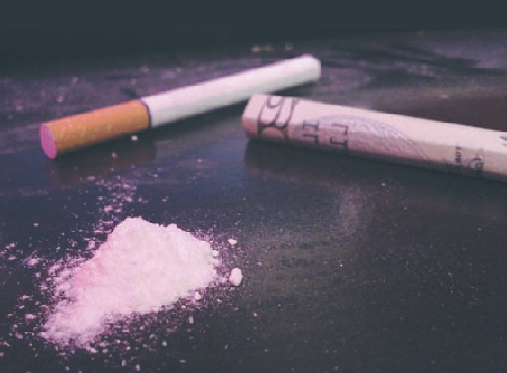In his bedroom, John pours a dime-sized amount of cocaine from a small plastic bag onto his desk. He scrapes it across the desktop, then chops it up with his CatCard — it sounds like he could be chopping vegetables. He then takes the unscrewed bottom half of a ballpoint pen and leans over. The light of the computer screen casts a shadow over his face. He plugs one nostril, inhales through the pen as he moves his head swiftly to the right, then tilts it back as if he has a nosebleed. After he takes a few extra sniffs, he leans away from the desk and smiles with content.
John, whose name has been changed by request, began using cocaine two years ago with some friends. He’s also a B-average student in the Eller College of Management, works 15 to 20 hours a week and generally goes through an eighth, or 3 1/2 grams, of cocaine in about two weeks.
A survey by Campus Health Service of 2,479 students found that, in the past 30 days, 2.5 percent of those students had used cocaine. In the past year, 6.6 percent of respondents used cocaine. The sample of students surveyed was random and varying, and these statistics provide an accurate description of overall cocaine use even though it did not sample all UA students, according to Lynn Reyes, an alcohol and other drug prevention specialist at Campus Health.
From Jan. 30, 2011, to Jan. 30, 2012, there were 361 reported drug-related calls around the university, according to University of Arizona Police Department records. Because of how the UAPD records are kept, it is impossible to know how many of those calls were cocaine-related.
Jake Fitzgerald, a studio art junior, said he uses cocaine on a regular basis as well.
“I use cocaine whenever it is available, but I try not to pay for it,” Fitzgerald said. “It keeps me in line with not getting addicted.”
Fitzgerald said he uses the drug one to two times a week. If someone offers him cocaine, he doesn’t refuse it, he said.
“It’s a fun drug,” Fitzgerald said. “All drugs can be used recreationally and responsibly in moderation, but outside of moderation, your life just goes down the toilet.”
Although John said he uses it to party, he also relies on cocaine to get through work and classes. During finals week, his use increases.
“When finals come around I’ll do it every day,” he said. “I know studies say it’s not good to study on, but I say that’s bullshit.”
Keith Boesen, the managing director at the Arizona Poison and Drug Information Center in the College of Pharmacy, said cocaine can be used to help individuals focus in similar ways that Adderall does, but neither should be used recreationally, Boesen said.
The problem, Boesen said, is that cocaine affects the brain and the body so much that it is not worth using for the sole purpose of studying or focusing on a singular task. It is not uncommon for people to use it in the same way as caffeine, Boesen said.
“I find it (cocaine) works better than coffee,” John said. “My grades don’t lie.”
Along with working 15 to 20 hours a week at his job while going to school full-time, John received one A and three B’s last semester.
“I’ve only had a couple of problems with it (cocaine),” John said. One time, he said he blacked out after mixing the drug with alcohol, but has not had any serious problems otherwise.
Sometimes, John said he has to take breaks from the drug because it is not always readily available.
“It’s not like cigarettes where you can buy it at a gas station,” John said.
He doesn’t always feel the need to go find it as soon as he can either, he said, because he doesn’t feel dependent on cocaine. Individuals have only a 5 percent risk of becoming dependent within the first two years after initial use, according to a 2005 study in the journal Neuropsychopharmacology.
John will put this to the test after graduation.
“Once I’m out of college,” John said, “I’m done.”









